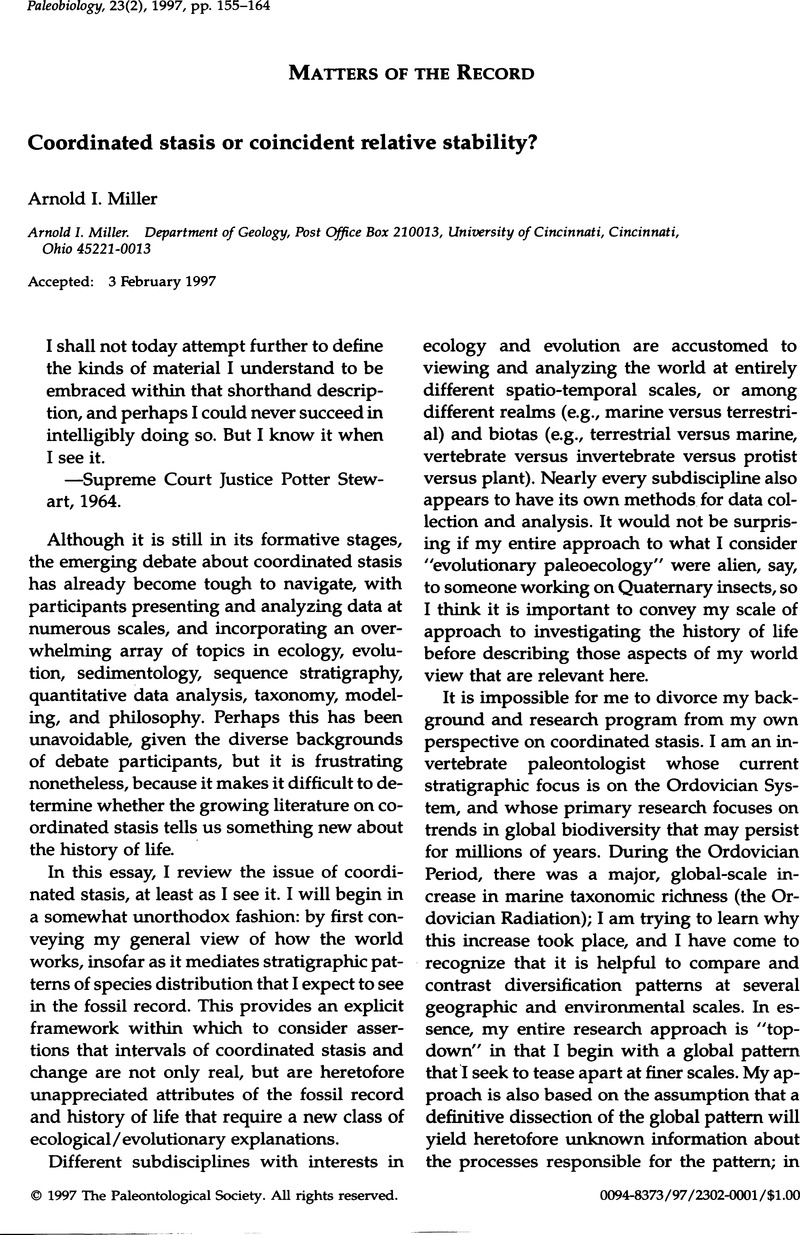Crossref Citations
This article has been cited by the following publications. This list is generated based on data provided by Crossref.
Miller, Arnold I.
1997.
Dissecting Global Diversity Patterns: Examples from the Ordovician Radiation.
Annual Review of Ecology and Systematics,
Vol. 28,
Issue. 1,
p.
85.
Miller, Arnold I.
1998.
Biotic Transitions in Global Marine Diversity.
Science,
Vol. 281,
Issue. 5380,
p.
1157.
Magurran, A. E.
May, R. M.
and
John Sepkoski, J.
1998.
Rates of speciation in the fossil record.
Philosophical Transactions of the Royal Society of London. Series B: Biological Sciences,
Vol. 353,
Issue. 1366,
p.
315.
Carroll, Robert L.
1999.
Steven M. Stanley: Macroevolution: Pattern and Process.
Journal of Vertebrate Paleontology,
Vol. 19,
Issue. 4,
p.
799.
Holland, Steven M.
1999.
The New Stratigraphy and its promise for paleobiology.
Paleobiology,
Vol. 25,
Issue. 3,
p.
409.
Budd, Ann F.
and
Johnson, Kenneth G.
1999.
Origination preceding extinction during late Cenozoic turnover of Caribbean reefs.
Paleobiology,
Vol. 25,
Issue. 2,
p.
188.
Miller, Arnold I.
2000.
Conversations about Phanerozoic global diversity.
Paleobiology,
Vol. 26,
Issue. S4,
p.
53.
Miller, Arnold I.
2000.
Conversations about Phanerozoic global diversity.
Paleobiology,
Vol. 26,
Issue. sp4,
p.
53.
Sepkoski, J.John
2001.
Encyclopedia of Biodiversity.
p.
97.
Sepkoski, J. John
2001.
Encyclopedia of Biodiversity.
p.
156.
Allmon, W.D.
2001.
Nutrients, temperature, disturbance, and evolution: a model for the late Cenozoic marine record of the western Atlantic.
Palaeogeography, Palaeoclimatology, Palaeoecology,
Vol. 166,
Issue. 1-2,
p.
9.
Roy, Kaustuv
2001.
Analyzing temporal trends in regional diversity: a biogeographic perspective.
Paleobiology,
Vol. 27,
Issue. 4,
p.
631.
SANCHEZ, T. M.
CARRERA, M. G.
and
WAISFELD, B. G.
2002.
Hierarchy of Factors Controlling Faunal Distribution: A Case Study from the Ordovician of the Argentine Precordillera.
PALAIOS,
Vol. 17,
Issue. 4,
p.
309.
Bush, Andrew M.
and
Bambach, Richard K.
2004.
Did Alpha Diversity Increase during the Phanerozoic? Lifting the Veils of Taphonomic, Latitudinal, and Environmental Biases.
The Journal of Geology,
Vol. 112,
Issue. 6,
p.
625.
Finnegan, Seth
and
Droser, Mary L.
2005.
Relative and absolute abundance of trilobites and rhynchonelliform brachiopods across the Lower/Middle Ordovician boundary, eastern Basin and Range.
Paleobiology,
Vol. 31,
Issue. 3,
p.
480.
Raia, P.
Piras, P.
and
Kotsakis, T.
2005.
Turnover pulse or Red Queen? Evidence from the large mammal communities during the Plio-Pleistocene of Italy.
Palaeogeography, Palaeoclimatology, Palaeoecology,
Vol. 221,
Issue. 3-4,
p.
293.
McGowran, Brian
2005.
Biostratigraphy.
Bonelli, James R.
Brett, Carlton E.
Miller, Arnold I.
and
Bennington, J Bret
2006.
Testing for faunal stability across a regional biotic transition: quantifying stasis and variation among recurring coral-rich biofacies in the Middle Devonian Appalachian Basin.
Paleobiology,
Vol. 32,
Issue. 1,
p.
20.
BRETT, C. E.
HENDY, A. J.W.
BARTHOLOMEW, A. J.
BONELLI, J. R.
and
MCLAUGHLIN, P. I.
2007.
RESPONSE OF SHALLOW MARINE BIOTAS TO SEA-LEVEL FLUCTUATIONS: A REVIEW OF FAUNAL REPLACEMENT AND THE PROCESS OF HABITAT TRACKING.
PALAIOS,
Vol. 22,
Issue. 3,
p.
228.
DOMINICI, S.
and
KOWALKE, T.
2007.
DEPOSITIONAL DYNAMICS AND THE RECORD OF ECOSYSTEM STABILITY: EARLY EOCENE FAUNAL GRADIENTS IN THE PYRENEAN FORELAND, SPAIN.
PALAIOS,
Vol. 22,
Issue. 3,
p.
268.



